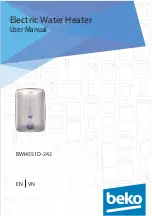
9
01023052
Why Water Gets Hard And How It Is Softened
All of the fresh water in the world originally falls as rain, snow, or sleet. Surface water is drawn
upward by the sun, forming clouds. Then, nearly pure and soft as it starts to fall, it begins to collect
impurities as it passes through smog and dust-laden atmosphere. And as it seeps through soil and
rocks it gathers hardness, rust, acid, unpleasant tastes and odors.
Water hardness is caused primarily by limestone dissolved from the earth by rainwater. Because of
this, in earlier times people who wanted soft water collected rainwater from roofs in rain barrels and
cisterns before it picked up hardness from the earth.
Some localities have corrosive water. A softener cannot correct this problem and so its printed
warranty disclaims liability for corrosion of plumbing lines, fixtures or appliances. If you suspect
corrosion, your Culligan Man has equipment to control the problem.
Iron is a common water problem. The chemical/physical nature of iron found in natural water
supplies is exhibited in four general types:
1.
Dissolved Iron—
Also called ferrous or “clear water” iron. This type of iron can be removed
from the water by the same ion exchange principle that removes the hardness elements, calcium
and magnesium. Dissolved iron is soluble in water and is detected by taking a sample of the
water to be treated in a clear glass. The water in the glass is initially clear, but on standing
exposed to the air, it may gradually turn cloudy or colored as it oxidizes.
2.
Particulate Iron—
Also called ferric or colloidal iron. This type of iron is an undissolved
particle of iron. A softener will remove larger particles, but they may not be washed out in
regeneration effectively and will eventually foul the ion exchange resin. A filtering treatment will
be required to remove this type of iron.
3.
Organic Bound Iron—
This type of iron is strongly attached to an organic compound in the
water. The ion exchange process alone cannot break this attachment and the softener will not
remove this type of iron.
4.
Bacterial Iron—
This type of iron is protected inside a bacteria cell. Like the organic bound
iron, it is not removed by a water softener.
When using a softener to remove both hardness and dissolved iron it is important that it regenerates
more frequently than ordinarily would be calculated for hardness removal alone. Although many
factors and formulas have been used to determine this frequency, it is recommended that the softener
be regenerated when it has reached 50–75% of the calculated hardness alone capacity. This will
minimize the potential for bed fouling. (Iron removal claims have not been verified by the Water
Quality Association.)
If you are operating a water softener on clear water iron, regular resin bed cleaning is needed to
keep the bed from coating with iron. Even when operating a softener on water with less than the
maximum of dissolved iron, regular cleanings should be performed. Clean every six months or more
often if iron appears in your conditioned water supply. Use resin bed cleaning compounds carefully
following the directions on the container.
How Your
Water
Conditioner
Works
Caution!
Do not use where the water is microbiologically unsafe or with water of unknown
quality without adequate disinfection before or after the unit.










































